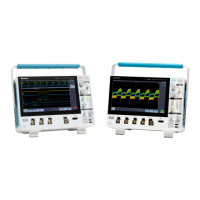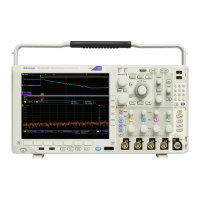Commands Listed in Alphabetical Order
Syntax
TRIGger:A:LOW
erthreshold:RF {<NR3>}
TRIGger:A:LOWerthreshold:RF?
Related Commands
TRIGger:A:TYPe, TRIGger:A:EDGE:COUPling, TRIGger:A:EDGE:SLOpe,
TRIGger:A:UPPerthreshold:RF
Arguments
<NR3> is a floating point number that specifies the threshold to use, in the
currently selected RF units (using RF:UNIts). The range is (ref level – 40 dBm) to
(ref level + 10 dBm), but never less than –65 dBm or more than +30 dBm.
Examples
TRIGger:A:LOWerthreshold:RF —1.000E+1 sets the threshold to –10 dBm.
TRIGger:A:LOWerthreshold:RF? might return -30.0000, indicating that the
threshold set to –30.000 dBm (assuming the units are currently set to dBm).
TRIGger:A:MODe
This command specifies the A trigger mode.
Group
Trigger
Syntax
TRIGger:A:MODe {AUTO|NORMal}
TRIGger:A:MODe?
Arguments
AUTO generates a trigger if one is not detected within a specified time period.
NORMal waits for a valid trigger event.
Examples
TRIGGER:A:MODE NORMAL specifies that a valid trigger event must occur before
atriggerisgenerated.
TRIGGER:A:MODE ? might return :T RIGGER:A:MODE NORMAL indicating that a
valid trigger event must occur before a trigger is generated.
TRIGger:A:PULse:CLAss
This command specifies which kind of pulse to trigger on (either runt, width,
transition (rise/fall or slew rate) or timeout). You also need to set the trigger type
to
PULSe using the command TRIGger:A:TYPe.
2-890 MDO4000/B/C, MSO/DPO4000B and MDO3000 Series Oscilloscopes Programmer Manual
